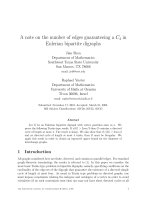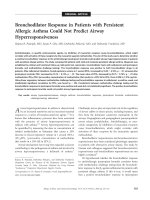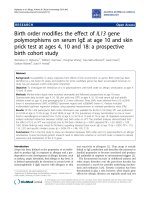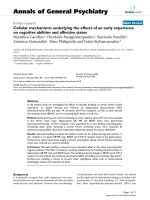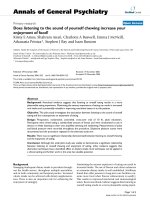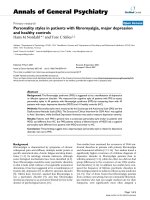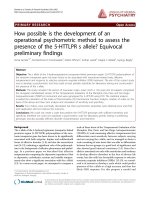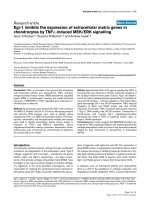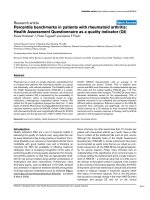Báo cáo y học: "Clinical significance in the number of involved lymph nodes in patients that underwent surgery for pathological stage III-N2 non-small cell lung cancer" pot
Bạn đang xem bản rút gọn của tài liệu. Xem và tải ngay bản đầy đủ của tài liệu tại đây (670.72 KB, 8 trang )
RESEARCH ARTICLE Open Access
Clinical significance in the number of involved
lymph nodes in patients that underwent surgery
for pathological stage III-N2 non-small cell lung
cancer
Takeshi Hanagiri
*
, Masaru Takenaka, Soich Oka, Yoshiki Shigematsu, Yoshika Nagata, Hidehiko Shimokawa,
Hidetaka Uramoto and Fumihiro Tanaka
Abstract
Purpose: This study investigated whether the number of involved lymph nodes is associated with the prognosis in
patients that underwent surgery for pathological stage (p-stage) III/N2 NSCLC.
Subjects: This study evaluated 121 patients with p-stage III/N2 NSCLC.
Results: The histological types included 65 adenocarcinomas, 39 squamous cell carcinomas and 17 others. The
average number of dissected lymph nodes was 23.8 (range: 6-55). The average number of involved lymph nodes
was 5.9 (range: 1-23). The 5-year survival rate of the patients was 51.0% for single lymph node positive, 58.9% for 2
lymph nodes positive, 34.2% for 3 lymph nodes positive, and 30.0% for 4 lymph nodes positive, and 20.4% for
more than 5 lymph nodes positive. The patients with either single or 2 lymph nod es positive had a significantly
more favorable prognosis than the patients with more than 5 lymph nodes positive. A multivariate analysis
revealed that the number of involved lymph nodes was a significant independent prognostic factor.
Conclusion: Surgery appears to be preferable as a one arm of multimodality therapy in p-stage III/N2 patients with
single or 2 involved lymp h nodes. The optimal incorporation of surgery into the multimodality approach therefore
requires further clinical investigation.
Keywords: non-small cell lung cancer, surgical resection, mediastial lymph node metastasis, number of involved
lymph nodes, skip metastasis, postoperative prognosis
Introduction
More than 1.6 million new cases of lung cancer are di ag-
nosed worldwide each year, causing approximately 1.3
million deaths annually and representing the highest
mortality rate in comparison to any other major malig-
nancies [1,2]. A surgical resection remains the mainstay
for patients with early stage non-small cell carcinoma
(NSCLC) [3]. However, lung cancer patients are often
diagnosed with advanced disease due to the aggressiv e-
ness of this type of cancer [4,5]. A careful staging workup
is very important to determine the optimal treatment
strategy. Chemotherapy and radiotherapy is the current
standard of care for pati ents with locally advan ced (stage
IIIA and stage IIIB) NSCLC. However, regardless of the
total dose of radiation and the optimal chemotherapy,
the outcome of stage III patients remains poor, with a
median survival of 10-15 months, and 5-year survival
rates of only 5-15% [6,7].
It is necessary to establish a treatment strategy to
improve their prognosis of pathological stage (p-stage)
III/N2 patients. Surgical intervention still plays a crucial
role in selected cases, for achieving better loco-regional
control and their favorable prognosis [8]. Generally, the
results of surgical treatment as a multimodality therapy
for pathological stage III are not satisfactory, because the
5-year survival rates range from 20 to 30% [9,10]. The
range in the survival of stage III NSCLC associated with
* Correspondence:
Second Department of Surgery, School of Medicine, University of
Occupational and Environmental Health, Kitakyushu 807, Japan
Hanagiri et al. Journal of Cardiothoracic Surgery 2011, 6:144
/>© 2011 Hanagiri et al; licens ee BioMed Central Ltd. This is an Open Access article distributed under the terms of the Creative Commons
Attribution License ( s/by/2.0), which permits unrestricted use, distribution, and reproduction in
any medium, provided the original work is properly cited.
variousprognosticfactorssuggeststhatpatientsatthe
N2 stage are a heterogeneous group [11,12]. Therefore,
the re is no consensus on the indications and the optimal
subjects for surgical resec tion. This study retrospectively
investigated whether the number of involved lymph
nodes is associated with prognosis in patients that under-
went surgery for p-stage III-N2 NSCLC. Identifying
patients who receive survival benefit from surgical resec-
tion will positively contribute to determining the optimal
treatment strategies.
Patients and Methods
The hospital records of 690 consecutive patients who
underwent a complete resection of NSCLC between 1995
and 2005 were reviewed. There were 469 patients with
N0 disease, 84 with N1 disease, and 137 patients with N2
disease. This study focused on 137 patients with p-stage
III/N2 NSCLC. Ten patients that underwent preoperative
chemotherapy or radiation, and 6 patients underwent
segmentectomy or partial resection of the lung were
excluded. The preoperative assessments included chest
roentgenography an d computed tomography (CT) of the
chest, and upper abdomen. The clinica l N2 status was
defined by the presence of a lymph node more than 1 cm
in the sho rt axis diameter . Bone sc intigraphy was per-
formed to detect bone metastasis. MRI (magnetic reso-
nance imaging) of the brain was routinely employed for
asse ssment of distant meta stasis. Bronchoscopy was rou-
tinely performed to obtain a pathological diagnosis by
transbronchial lung biopsy, and to evaluate endobron-
chial staging. The patients’ records, including their clini-
cal data, preoperative examination results, details of any
surgeries, histopathologic al findings, and the TNM stages
of all patients were also reviewed.
The patients underwent lobectomy, bilobectomy or
pneumonectomy were enrolled in this study. A complete
mediastinal lymphadenectomy was routinely performed.
After surgery, en bloc dissected tissues were separated into
each lymph node precisely. All resected specimens, includ-
ing the primary tumor and resected hilar and mediastinal
lymph nodes, were examined to determine both the tumor
histology and the extent of lymph node metastases. Intrao-
perat ive frozen sections were examined if invasion of the
tumor was suspected at the surgical margins. The histo-
pathological findin gs were classified according to the
World Health Organization criteria, and the UICC TNM
staging system (7th edition) was also employed [5,13]. We
investigated the association between total number of
involved lymph nodes including hilar and mediastinal
lymph nodes, and survival. We also investigated the asso-
ciation between skip mediastinal ly mph nodes metastasis
and survival. Skip metastasis was defined as mediastinal
lymph nodes metastasis without hilar lymph nodes
metastasis.
Postoperative systemic chemotherapy was performed for
patients with stage III disease if the patients could tolerate
such treatment after surgery, or unless the patients refused
additional chemotherapy. The chemotherapy regimen
used was carboplatin + paclitaxel, or carboplatin +
gemcitabine.
Follow-up information was obtained from all patients
through office visits or telephone interviews either with
the patient, with a relative, or with their primary physi-
cians. The patients were evaluated every 3 months by
chest roentgenography, and chest CT scans and bone
scintigraphy were performed every 6 months for the
first 2 years after surgery and annually thereafter. The
mean duration of observation was 57 months.
The survival curve was calculated by the Kaplan-Meier
method, and the data were compared using the Log-rank
test for a univariate analysis. Prognostic factors were ana-
lyzed by a multivariate analysis using Cox’s proportional
hazard model to adjust for potential confounding factors.
Categorical variables were compared by Fisher’s exact test.
The differences were considered to be significant, if the p
value was less than 0.05. The StatView V software package
(Abacus Concept, Berkeley, CA) was used for all statistical
analyses.
Results
There were 121 patients who underwent either a pneumo-
nectomy, bilobectomy or lobectomy for p-stage III/N2
NSCLC. The patients i ncluded 89 males and 32 females
(Table 1). The mean age of the patients was 67.2 years
(range: 44-85). One hundred patients (82.6%) had a smok-
ing habit. The histological types included 65 adenocarci-
nomas (53.7%), 39 squamous cell carcinomas (32.2%) and
13 large cell carcinoma (10.7%) and 4 adenosquamous car-
cinomas (3.3%). There were 27 patients in T1, 53 in T2, 32
in T3, and 9 in T4 (stage IIIB). Clinical stages were diag-
nosed as stage I in 46 patients, stage II in 6, and st age III
in 69. A pneumonectomy was performed in 25 (20 .7%), a
bilobectomy in 9 (7.4%), and a lobectomy in 87 (71.9%).
The average number of dissected lymph nodes (N1 and
N2) was 23.8 (range: 6-55). The average number of
involved lymph nodes (N1 and N2) was 5.9 (range: 1-23).
Skip mediastinal lymph nodes metastasis (N1 negative)
was demonstrated in 41 patients (33.8%), and mediastinal
lymph nodes metastasis with N1 disease (N1 positive) was
found in 80 patients. The number of metastatic lymph
nodes in patients with skip mediastinal lymph nodes
metastasis was 1 in 17 patients, 2 in 7 patients, and ≥ 3in
17 patients.
The 5-year survival rate after surgery according to the
pathological N stage (N0. N1. and N2) was 72.3%, 58.1%,
and 33.4%, respectively (Figure 1). Among, the 5-year
survival rate of patients with mediastinal lymph node
metastasis (N2) th at had skip mediastinal ly mph nodes
Hanagiri et al. Journal of Cardiothoracic Surgery 2011, 6:144
/>Page 2 of 8
metastasis (without N1 lymph node metastasis) was
41.7%; however that of mediastinal lymph nodes metasta-
sis (N2) with N1 disease was 30.1% (F igure 2). The prog-
nosis of patients with skip mediastinal lymph nodes
metastasis showed a better tendency for survival, but
there was no significant difference (p = 0. 216). As
regards the total number of involved lymph node, the 5-
year survival rate of the single lymph node positive
patients was 51.0%, 58.9% for 2 lymph nodes positive,
34.2% for 3 lymph nodes positive, and 30.0% for 4 lymph
nodes positive, and 20.4% for more than 5 lymph nodes
positive (Figure 3). The patients with either single or 2
lymph nodes positive ha d a signifi cantly better pr ognosis
than the patients with more than 5 lymph nodes positive.
The 5-year survival rate in the patients with 2 or less
than 2 lymph nodes positive was 55.2%, whereas the 5-
year survival rate in the patients with more than 2 lymph
nodes positive was 24.7% (p < 0.001; Figure 4). There was
no significant difference between the patients with N1
disease and the patients with 2 or less than 2 lymph
nodes metastasis.
A univariate analysis of survi val in patients with stage
III NSCLC showed that T factor (T1 vs. T2-4, p =
0.0125), Surgical procedure (pneumonectomy or
bilobectomy vs. lobectomy, p = 0.0345) and number of
involved lymph nodes (≤2 vs. 3 ≤, p = 0.0041) were sig-
nificant prognostic factors (Table 2). A multivariate ana-
lysis using these significant variables (T factor, surgical
procedure, and number of involved lymph node) showed
that the hazard ratio of the number of involved lymph
node was 0.456 (95% confidence interval 0.265 - 0.785,
p = 0.0046), thus indicating that it is a significant inde-
pendent prognostic factor for p-stage III/N2 NSCLC
(Table 3).
Discussion
NSCLC represents one of the most common and aggres-
sive solid tumors, and it is difficult to cure. Reducing the
mortality of lung cancer is an important public health
issue. The status of lymph nodes is critical in planning
treatment strategies if there is no distant metastasis. A
complete surgical resection is considered to be the first
line treatment for individuals with stage I-II NSCLC.
However, more than half of the patients with NSCLC are
diagnosed with N2-3 or M1 disease [14]. While che-
motherapy for patients with advanced NSCLC prolongs
surviv al and improves their quality of life, the majority of
advanced stage patients succumb to disease within 2
years, thus, there is room for improvement [15]. The
Japanese Lung Cancer Registry Study of 6644 resected
NSCLC cases in Japan reported the 5-year survival rate
for patients with stage IIIA and IIIB were 32.8% and
30.4%, respectively [10]. The 5-year survival rate for the
patients with p-stage III was 33.4% in the current series,
which was consistent with the Japanese Lung Cancer
Registry Study. The indications for surgical treatment has
remained mostly uncha nged for a few decades. However,
optimal therapeutic selection for stage III NSCLC is con-
troversial. Presentations of stage III NSCLC range from
apparently resectable tumors with single nodal metastasis
to unresectable, bulky multi-station nodal dise ase, neces-
sitating different treatment strategies. These heteroge-
neous subsets of stage III patient s h ave been observed in
a wide variety of clinical trials incorporating various com-
binations of chemotherapy, radiotherapy, and surgery.
The evidence of whether surgical treatment for stage III/
N2 disease improves the prognosis is unclear.
Skip metastasis is defined as the presence of mediastinal
lymph node metastasis (N2 disease) without intra-lobar or
hilar nodal involvement (N1). The mechanism of skip
metastasis is tho ught to be direct subpleural lymphatic
spread to the mediastinum. The incidence of skip N2
metastases is 20% to 40% of all N2 diseases, but the nature
and clinical significance remain unclear [16]. Some investi-
gators report that skip metastatic disease is a favorable N2
subset, possibly because it is usually associated with sin-
gle-level N2 metastatic involvement [17,18]. The phenom-
enon of skip metastasis was pathologically identified in 41
Table 1 Characteristics of the patients at p-stage III/N2
Average of age (range) 67.2 (44-85)
Gender; male/female 89/32
Histology
Adenocarcinoma 65
Squamous cell carcinoma 39
Large cell carcinoma 13
Adenosquamous cell carcinoma 4
T factor
T1 27
T2 53
T3 32
T4 9
Clinical Stage
I46
II 6
III 69
Operative procedure
Operative procedure
Pneumonectomy 25
Bilobectomy 9
Lobectomy 87
Number of involved lymph nodes (N1 +N2)
117
221
319
410
≥554
Hanagiri et al. Journal of Cardiothoracic Surgery 2011, 6:144
/>Page 3 of 8
Figure 2 Overal l survival curves after surgery in p-N2 patients with/without skip metastasis . The 5-year survival rate of skip mediastinal
lymph nodes metastasis (41.7%) was better than that of mediastinal lymph nodes metastasis (N2) with N1 disease (30.1%). However, there was
no significant difference (p = 0.216).
Figure 1 Overall survival curves after surgery according to the pathological N fact or. The 5-year survival rate after surgery according to
the pathological N stage (N0, N1, and N2) was 72.3%, 58.1%, and 33.4%, respectively.
Hanagiri et al. Journal of Cardiothoracic Surgery 2011, 6:144
/>Page 4 of 8
Figure 4 Comparison of the overall surviva l between p-N1 patie nts and p-N2 patients with 2 or less than 2 involved lymph nodes.
There was no significant difference between the patients with N1 disease and the patients with 2 or less than 2 lymph nodes metastasis.
Figure 3 Overall survival curves after surgery in p-N2 patients according to the number of involved lymp h nodes. The 5-year survival
rate of the patients was 51.0% for single lymph node positive, 58.9% for 2 lymph nodes positive, 34.2% for 3 lymph nodes positive, 30.0% for 4
lymph nodes positive, and 20.4% for more than 5 lymph nodes positive.
Hanagiri et al. Journal of Cardiothoracic Surgery 2011, 6:144
/>Page 5 of 8
of the current patients (33.8%). The patients with skip
metastasis showed a better tendency for survival, but there
was no significant surviva l di fference between patients
with skip metastasis compared to those without (p = 0.
216).
Thepresentstudyfocusedonthenumberofinvolved
lymph nodes in regional lymph node (N1 and N2). The 5-
years survival rates of the patients at stage III/N2 was
decreased acc ording to the total number of involved lymph
node (N1 + N2). The patients with 2 or fewer lymph node
metastases had significantly better prognosis than those
with 3 or more lymph node metastasis. Previous investiga-
tors demonstrated the single N2 disease showed favorable
prognosis that mult iple N2 disease [12,19]. However, the
present study indicated prognostic information concerning
subpopulation o f patient s with 2 or fewer lymph node
metastases. The prognosis of patients with N2 lymph node
metastasis in 2 or fewer nodes was co mparable to the
results of patients with N1 disease. In the multivariate
analysis, T factor and the number of involved lymph node
are a lso signi ficant independent prognostic factors for
patients with p-stage I II/N2 NSCLC.
Several investigators demonstrated the effectiveness of
induction chemotherapy [20]. Most studies report that
surgical resection is recommended only for patients with
mediastinal downstaging after chemotherapy, and no t all
patients with persistent mediastinal disease will benefit
from surgery [21,22]. Clinical restaging is often inaccurate
and appropriate selection of patients to undergo surgical
resection following induction therapy is critical [23].
Lobectomy may be safely performed following induction
therapy while pneumonectomy may carry a high and pos-
sibly unacceptabl e rate of perioperative mortality [23,24].
Decaluwé et al. suggested that the baseline single level N2
disease is an independent prognostic factor for long-term
survival in surgical multimodality treatment [25]. Stupp
et al. reported that neoadjuvant chemotherapy and radio-
therapy followed by surgery in selected patients with stage
IIIB NSCLC was feasible, and their 5-years survival was
40%, indicating it was comparable to the results of com-
bined treatment for stage IIIA disease [26].
The present status of postoperative adjuvant che-
motherapy for completely resected stage IIIA NSCLC is
recommended based on the results of the large-scale
phase III trials, using cisplatin-based regimens, such as
IALT and ANITA studies, and a recent individual patient
meta- analysis [27-29 ]. The clinical value of postoperative
radiotherapy (PORT) in stage N2 non-small-cell lung
cancer (NSCLC) is controversy [30]. Postoperati ve ra dio-
therapy may be considered for fit patients with comple-
tely resected NSCLC with N2 nodal invo lvement,
preferably after the completion of adjuvant chemotherapy
[31]. A large multi-institutional randomized trial of
PORT in these patient populations is now underway.
This retrospective study tried to clarify the prognostic
importance of the number of involved lymph nodes in
patients with p-stage III/N2 NSCLC who underwent com-
plete dissection of the mediastinal lymph nodes. In conclu-
sion, patients with 2 or fewer nodal involvement have the
greater chance for cure an d surgery has a significant role
in their treatment. Patients with multi-station disease are
frequently not amenable to complete resection and ma y
be best approached with definitive chemotherapy and
radiation. However, it is not possible to estimate exact
Table 3 Multivariate Cox proportional hazard analysis of the overall survival
Factors relative risk 95% confidence interval p value
T factor
(T1 vs T2-4)
0.521 0.285 - 0.953 0.0344
Surgical procedure
((Pneumonectomy/bilobectomy vs Lobectomy)
0.676 0.417 - 1.097 0.1131
Number of involved lymph nodes
(l or 2 vs 3≤)
0.456 0.265 - 0.785s 0.0046
Table 2 Survival of patients with p-stage III/N2 NSCLC by
a univariate analysis (log-rank test)
n Survival (%) p value
Age
<75 years 91 32.0 0.3519
≥ 75 years 30 39.5
Gender
Male 89 33.0 0.3981
Female 32 40.2
T factor
T1 27 47.8 0.0125
T2-4 94 30.8
Histology
Adenocarcinoma 63 41.0 0.0637
Others 58 28.2
Surgical procedure
Pneumonectomy/bilobectomy 34 20.7 0.0345
Lobectomy 87 40.1
Skip metastasis
Yes 41 41.7 0.2156
No 80 30.1
Number of involved lymph nodes
1 or 2 37 55.2 0.0041
3≤ 84 24.7
Hanagiri et al. Journal of Cardiothoracic Surgery 2011, 6:144
/>Page 6 of 8
number of lymph nodes by using cur rent stagi ng techni-
que including mediastinoscopy and endobronchial ultra-
sound guided transbronchial fine needle aspiration
cytology. The optimal incorporation of surgery into the
multimodal approach therefore requires further clinical
investigations in patients with p-stage III/N2 NSCLC.
Authors’ contributions
TH conceived of the study, and drafted the manuscript. MT participated in
the study and performed the statistical analysis. SO, YS, YN, HS, HU, and FT
participated in the study and coordination. All authors read and approved
the final manuscript.
Conflict of interest statement
The authors declare that they have no competing interests.
Received: 8 August 2011 Accepted: 25 October 2011
Published: 25 October 2011
References
1. Jemal A, Siegel R, Xu J, Ward E: Cancer statistics, 2010. CA Cancer J Clin
2010, 60:277-300.
2. Ferlay J, Shin HR, Bray F, Forman D, Mathers C, Parkin DM: Estimates of
worldwide burden of cancer in 2008: GLOBOCAN 2008. Int J Cancer 2010.
3. Hanagiri T, Baba T, So T, Yasuda M, Sugaya M, Ono K, So T, Uramoto H,
Takenoyama M, Yasumoto K: Time trends of surgical outcome in patients
with non-small cell lung cancer. J Thorac Oncol 2010, 5:825-9.
4. Ou SH, Zell JA: Validation study of the proposed IASLC staging revisions of
the T4 and M non-small cell lung cancer descriptors using data from 23,583
patients in the California Cancer Registry. JThoracOncol2008, 3:216-27.
5. Goldstraw P, Crowley J, Chansky K, Giroux DJ, Groome PA, Rami-Porta R,
Postmus PE, Rusch V, Sobin L: International Association for the Study of
Lung Cancer International Staging Committee; Participating Institutions.
The IASLC Lung Cancer Staging Project: proposals for the revision of the
TNM stage groupings in the forthcoming (seventh) edition of the TNM
Classification of malignant tumours. J Thorac Oncol 2007, 2:706-14.
6. Sause W, Kolesar P, Taylor S IV, Johnson D, Livingston R, Komaki R,
Emami B, Curran W Jr, Byhardt R, Dar AR, Turrisi A: Final results of phase III
trial in regionally advanced unresectable non-small cell lung cancer:
Radiation Therapy Oncology Group, Eastern Cooperative Oncology
Group, and Southwest Oncology Group. Chest 2000, 117:358-64.
7. Okamoto I: Overview of chemoradiation clinical trials for locally
advanced non-small cell lung cancer in Japan. Int J Clin Oncol 2008,
13:112-6.
8. Farray D, Mirkovic N, Albain KS: Multimodality therapy for stage III non-
small-cell lung cancer. J Clin Oncol 2005, 23:3257-69.
9. Chansky K, Sculier JP, Crowley JJ, Giroux D, Van Meerbeeck J, Goldstraw P:
International Staging Committee and Participating Institutions. The
International Association for the Study of Lung Cancer Staging Project:
prognostic factors and pathologic TNM stage in surgically managed
non-small cell lung cancer. J Thorac Oncol 2009, 4:792-801.
10. Goya T, Asamura H, Yoshimura H, Kato H, Shimokata K, Tsuchiya R,
Sohara Y, Miya T, Miyaoka E: The Japanese Joint Committee of Lung
Cancer Registry. Prognosis of 6644 resected non-small cell lung cancers
in Japan: a Japanese lung cancer registry study. Lung Cancer 2005,
50:227-34.
11. Andre F, Grunenwald D, Pignon JP, Dujon A, Pujol JL, Brichon PY,
Brouchet L, Quoix E, Westeel V, Le Chevalier T: Survival of patients with
resected N2 non-small-cell lung cancer: evidence for a subclassification
and implications. J Clin Oncol 2000, 18:2981-9.
12. Inoue M, Sawabata N, Takeda S, Ohta M, Ohno Y, Maeda H: Results of
surgical intervention for p-stage IIIA (N2) non-small cell lung cancer:
acceptable prognosis predicted by complete resection in patients with
single N2 disease with primary tumor in the upper lobe. J Thorac
Cardiovasc Surg 2004, 127:1100-6.
13. Travis WD, Colby TV, Corrin B, Shimosato Y, Brambilla E, eds: Histological
type of lung and pleural tumors. World Health Organization international
histological classification of tumors. 3 edition. Berlin: Springer; 1999.
14. Groome PA, Bolejack V, Crowley JJ, Kennedy C, Krasnik M, Sobin LH,
Goldstraw P: IASLC International Staging Committee; Cancer Research
and Biostatistics; Observers to the Committee; Participating Institutions.
The IASLC Lung Cancer Staging Project: validation of the proposals for
revision
of the T, N, and M descriptors and consequent stage groupings
in the forthcoming (seventh) edition of the TNM classification of
malignant tumours. J Thorac Oncol 2007, 2:694-705.
15. Ohe Y, Ohashi Y, Kubota K, Tamura T, Nakagawa K, Negoro S, Nishiwaki Y,
Saijo N, Ariyoshi Y, Fukuoka M: Randomized phase III study of cisplatin
plus irinotecan versus carboplatin plus paclitaxel, cisplatin plus
gemcitabine, and cisplatin plus vinorelbine for advanced non-small-cell
lung cancer: Four-Arm Cooperative Study in Japan. Ann Oncol 2007,
18:317-23.
16. Ilic N, Petricevic A, Arar D, Kotarac S, Banovic J, Ilic NF, Tripkovic A,
Grandic L: Skip mediastinal nodal metastases in the IIIa/N2 non-small cell
lung cancer. J Thorac Oncol 2007, 2:1018-21.
17. Prenzel KL, Mönig SP, Sinning JM, Baldus SE, Gutschow CA, Grass G,
Schneider PM, Hölscher AH: Role of skip metastasis to mediastinal lymph
nodes in non-small cell lung cancer. J Surg Oncol 2003, 82:256-60.
18. Riquet M, Assouad J, Bagan P, Foucault C, Le Pimpec Barthes F, Dujon A,
Danel C: Skip mediastinal lymph node metastasis and lung cancer: a
particular N2 subgroup with a better prognosis. Ann Thorac Surg 2005,
79:225-33.
19. Misthos P, Sepsas E, Kokotsakis J, Skottis I, Lioulias A: The significance of
one-station N2 disease in the prognosis of patients with nonsmall-cell
lung cancer. Ann Thorac Surg 2008, 86:1626-30.
20. Roth JA, Fossella F, Komaki R, Ryan MB, Putnam JB Jr, Lee JS, Dhingra H, De
Caro L, Chasen M, McGavran M: A randomized trial comparing
perioperative chemotherapy and surgery with surgery alone in
resectable stage IIIA non-small-cell lung cancer. J Natl Cancer Inst 1994,
86:673-80.
21. Betticher DC, Hsu Schmitz SF, Tötsch M, Hansen E, Joss C, von Briel C,
Schmid RA, Pless M, Habicht J, Roth AD, Spiliopoulos A, Stahel R, Weder W,
Stupp R, Egli F, Furrer M, Honegger H, Wernli M, Cerny T, Ris HB:
Mediastinal lymph node clearance after docetaxel-cisplatin neoadjuvant
chemotherapy is prognostic of survival in patients with stage IIIA PN2
non-small-cell lung cancer: a multicenter phase II trial. J Clin Oncol 2003,
21:1752-1759.
22. Lorent N, De Leyn P, Lievens Y, Verbeken E, Nackaerts K, Dooms C, Van
Raemdonck D, Anrys B, Vansteenkiste J, Leuven Lung Cancer Group: Long-
term survival of surgically staged IIIA-N2 non-small-cell lung cancer
treated with surgical combined modality approach: analysis of a 7-year
prospective experience. Ann Oncol 2004, 15:1645-1653.
23. Tieu BH, Sanborn RE, Thomas CR Jr: Neoadjuvant therapy for resectable
non-small cell lung cancer with mediastinal lymph node involvement.
Thorac Surg Clin 2008, 18:403-15.
24. Albain KS, Swann RS, Rusch VW, Turrisi AT, Shepherd FA, Smith C, Chen Y,
Livingston RB, Feins RH, Gandara DR, Fry WA, Darling G, Johnson DH,
Green MR, Miller RC, Ley J, Sause WT, Cox JD: Radiotherapy plus
chemotherapy with or without surgical resection for stage III non-small-
cell lung cancer: a phase III randomised controlled trial. Lancet 2009,
374:379-86.
25. Decaluwé H, De Leyn P, Vansteenkiste J, Dooms C, Van Raemdonck D,
Nafteux P, Coosemans W, Lerut T: Surgical multimodality treatment for
baseline resectable stage IIIA-N2 non-small cell lung cancer. Degree of
mediastinal lymph node involvement and impact on survival. Eur J
Cardiothorac Surg 2009, 36:433-9.
26. Stupp R, Mayer M, Kann R, Weder W, Zouhair A, Betticher DC, Roth AD,
Stahel RA, Majno SB, Peters S, Jost L, Furrer M, Thierstein S, Schmid RA, Hsu-
Schmitz SF, Mirimanoff RO, Ris HB, Pless M: Neoadjuvant chemotherapy
and radiotherapy followed by surgery in selected patients with stage IIIB
non-small-cell lung cancer: a multicentre phase II trial. Lancet Oncol 2009,
10
:785-93.
27.
Arriagada R, Bergman B, Dunant A, Le Chevalier T, Pignon JP,
Vansteenkiste J: International Adjuvant Lung Cancer Trial Collaborative
Group. Cisplatin-based adjuvant chemotherapy in patients with
completely resected non-small-cell lung cancer. N Engl J Med 2004,
350:351-60.
28. Douillard JY, Rosell R, De Lena M, Carpagnano F, Ramlau R, Gonzáles-
Larriba JL, Grodzki T, Pereira JR, Le Groumellec A, Lorusso V, Clary C,
Torres AJ, Dahabreh J, Souquet PJ, Astudillo J, Fournel P, Artal-Cortes A,
Hanagiri et al. Journal of Cardiothoracic Surgery 2011, 6:144
/>Page 7 of 8
Jassem J, Koubkova L, His P, Riggi M, Hurteloup P: Adjuvant vinorelbine
plus cisplatin versus observation in patients with completely resected
stage IB-IIIA non-small-cell lung cancer (Adjuvant Navelbine
International Trialist Association [ANITA]): a randomised controlled trial.
Lancet Oncol 2006, 7:719-27.
29. Pignon JP, Tribodet H, Scagliotti GV, Douillard JY, Shepherd FA,
Stephens RJ, Dunant A, Torri V, Rosell R, Seymour L, Spiro SG, Rolland E,
Fossati R, Aubert D, Ding K, Waller D, Le Chevalier T, LACE Collaborative
Group: Lung adjuvant cisplatin evaluation: a pooled analysis by the
LACE Collaborative Group. J Clin Oncol 2008, 26:3552-9.
30. PORT Meta-analysis Trialists Group: Postoperative radiotherapy for non-
small cell lung cancer. Cochrane Database Syst Rev 2005, 18:CD002142.
31. Krupitskaya Y, Loo BW Jr: Post-operative radiation therapy (PORT) in
completely resected non-small-cell lung cancer. Curr Treat Options Oncol
2008, 9:343-56.
doi:10.1186/1749-8090-6-144
Cite this article as: Hanagiri et al.: Clinical significance in the number of
involved lymph nodes in patients that underwent surgery for
pathological stage III-N2 non-small cell lung cancer. Journal of
Cardiothoracic Surgery 2011 6:144.
Submit your next manuscript to BioMed Central
and take full advantage of:
• Convenient online submission
• Thorough peer review
• No space constraints or color figure charges
• Immediate publication on acceptance
• Inclusion in PubMed, CAS, Scopus and Google Scholar
• Research which is freely available for redistribution
Submit your manuscript at
www.biomedcentral.com/submit
Hanagiri et al. Journal of Cardiothoracic Surgery 2011, 6:144
/>Page 8 of 8
